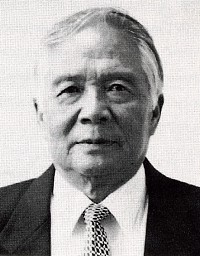Song Wencong
- Birthdate
- 1930/03/23
- Birthplace
- Dali, Yunnan
- Death date
- 2016/03/22
- Associated organizations
- National Committee of Management Standard Technology for Armament System Engineering, member of the first session of Science and Technology Committee of Aviation Industry, director of Academic Committee of Major Aviation Science and Technology Laboratory for Fighter Integration Simulation, member of the 7th Session of Sichuan committee of the Chinese People's Political Consultative Congress, member of the Multi-Academics Experts Group of Senior Aviation Hi-Tech Personnel Training Center of Beijing Aeronautics & Aerospace University, Nanjing Aeronautics & Aerospace University and Northwest Polytechnic University
- Fields of study
- Mechanical Engineering, Aeronautics
- Awards
- Prize of Science and Technical Progress by the ministry of Aviation Industry, National Advanced Worker, Aviation Golden Prize of Dedication to the Country, 2nd level prize of national science and technology progress
Biography
Song Wencong was a Chinese aeronautical engineer responsible for the creation of the J-10 fighter jet.
Song Wencong was born in the town of Dali, Yunnan on March 23rd in the year 1930, and witnessed much turmoil and change during his childhood. Iin 1937 during the War of Resistance against Japan, seven-year-old Song spent most of his time hiding in air-raid shelters. In an interview, he noted that "at the time, an alarm rang when Chinese aircraft were defeated by the Japanese ones. The Chinese Air Force had no power to resist rivals, which proved an old saying- falling behind will make you take more blows." These events that transpired at an early age motivated Wencong to develop the J-10 aircraft in order to insure China would have aerial dominance. [1]
In July of 1948, Wencong chose to join as a youth member into the Communist Party of China, and in 1949 he enlisted into the Yunnan-Guangxi-Guzihou border region as a scout. Eventually, Wencong joined the Chinese People's Volunteer Army to fight against American-led U.N. forces in the May of 1951 during the Korean War. [2]
After he returned from the Korean War, Wencong waited three years till he entered into the Harbin Institute of Military Engineering in August of 1954, where he majored in aircraft engines at the Air Force Engineering Department in 1959. After graduation, he was assigned to work in the Shenyang Aircraft Factory as a leader of the general layout group in 1961. Working there for 9 years, in 1970 he eventually began his work in the Chengdu Aircraft Design and Research Institute as the director of the general layout and aerodynamic research department, vice director, and eventually chief designer. [3]
During the 1970's, Wencong predominantly spent a majority of his time initiating and organizing research into a short interval canard layout, undertaking a great deal of wind tunnel tests, and calculating analysis and general scheme demonstrations, and made a great deal of progress for the third generation fighter's development [4].
In the 1980's, China was falling behind the west in aircraft technology. Wencong was determined to bring modern air superiority to China. In 1986 Wencong established the Chengdu Aircraft Design and Research Institute in China's southwestern Sichuan Province, where he officially began to develop the J-10[5].
Over years of testing design models, performing evaluations in wind tunnels, and researching statistics, Wencong and his team were able to successfully make significant strides in the J-10's development. As a result, in only a year, him and the team had performed over 10,000 wind tunnel tests, and accumulated millions of test data statistics. The data successfully reduced the weight of the plane body by 26 kilograms, setting a world record for fighter weight control[6].
Eventually, after 10 years of development, the team finally produced the first J-10 for trail. Checking if everything was in check, the plane took its first flight on March 23rd, 1998. Later that day, Wencong made the decision to change his official birthday to March 23rd,.[7].
Following the successful flight of the J-10, Wencong went on to publish many academic papers regarding the study and development of aerodynamics. From his Development Strategy Study on China's military Aviation Technology in year 2000, he was awarded the first Prize of Science and Technical Progress by the ministry of Aviation Industry. In the year 2000, the state council conferred him the name of "National Advanced Worker." In 2001, he was awarded the "Aviation Golden Prize of Dedication to the Country" by Avic I[8].
In the year 2003, Wencong was elected a member of the Chinese Academy of Engineering. Eventually on December 29, 2006, the Chinese Air Force had equipped the new generation of J-10 fighters as their primary aircraft[9]. In March of 2016, at the age of 85 Wencong passed away at the 301 Military Hospital in Beijing.
References
- ↑ http://english.cri.cn/7146/2010/02/26/1461s552590.htm
- ↑ https://www.deadfamous.info/song-wencong-chinese-aircraft-designer-and-academic-died-at-85
- ↑ http://www.hlhl.org.cn/english/showsub.asp?id=485
- ↑ http://www.hlhl.org.cn/english/showsub.asp?id=485
- ↑ http://english.cri.cn/7146/2010/02/26/1461s552590.htm
- ↑ http://english.cri.cn/7146/2010/02/26/1461s552590.htm
- ↑ http://english.cri.cn/7146/2010/02/26/1461s552590.htm
- ↑ http://www.hlhl.org.cn/english/showsub.asp?id=485
- ↑ http://english.cri.cn/7146/2010/02/26/1461s552590.htm
